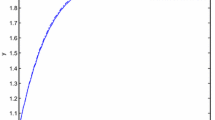Summary
By means of a combined method it is demonstrated for regular perturbation problems how the higher order terms of an asymptotic expansion may be determined from numerical solutions of the non-expanded basic equations.
The method is applied to heat transfer effects in a laminar boundary layer and to the analysis of its stability. All first- and second-order coefficients of the problem are determined from numerical solutions of the basic set of equations.
Similar content being viewed by others
References
Van Dyke, M.: Computer-extended series. Ann. Rev. Fluid Mech. 16 (1984) 287–309
Van Dyke, M.: Extended Stokes series: laminar flow through a heated horizontal pipe. J. Fluid Mech. 212 (1990) 289–308
Hirschel, E. H.; Schmatz, M. A.: Zonal solutions for viscous flow problems. In: Hirschel, E.H. (ed.) Finite approximations in fluid mechanics. Notes Num. Fluid Mech. 14 (1986) 99–112
Wanie, K. M.;Schmatz, M. A.;Monnoyer F.: A close coupling procedure for zonal solutions of the Navier-Stokes, Euler and boundary-layer equations. Z. Flugwiss. Weltraumforsch. 11 (1987) 347–359
Patel, V. C.;Rodi, W.;Scheuerer, G.: Turbulence models for near-wall and low Reynolds number flows: A review. AIAA Journal 23 (1987) 1308–1319
Euvrard, D.: A mutually profitable alliance: Asymptotic expansions and numerical computations. J. Theoretical Appl. Mech. Numero special (1986) 25–46
Gersten, K.;Herwig, H.: Strömungsmechanik. Braunschweig: Vieweg-Verlag 1992
Herwig, H.;Wickern, G.: The effect of variable properties on laminar boundary layer flow. Wärme- und Stoffübertragung 20 (1986) 47–57
Herwig, H.;Schäfer, P.: Influence of variable properties on the stability of two-dimensional boundary layers. J. Fluid Mech. 243 (1992) 1–14
Herwig, H.: An asymptotic approach to compressible boundary layer flow. Int. J. Heat Mass Transfer 30 (1987) 59–68
Schäfer, P.: Untersuchungen von Mehrfachlösungen. bei laminaren Strömungen. Dissertation, Ruhr-Universität Bochum, 1995
Morkovin, M. V.;Reshotko, E.: Dialogue on progress and issues in stability and transition research. In: Arnal, D.; Michel, R. (eds.) Laminar-Turbulent Transition. Berlin: Springer 1990
Schäfer, P.;Herwig, H.: Stability of plane Poiseuille flow with temperature dependent viscosity. Int. J. Heat Mass Transfer 36 (1993) 2441–2448
Schäfer, P.;Severin, J.;Herwig, H.: The effect of heat transfer on the stability of laminar boundary layers. Int. J. Heat Mass Transfer 38 (1995) 1855–1863
Harrison, S. B.; Mee, D. J.; Jones, T. V.: Experiment on the influence of heating on boundary layer transition in favourable pressure gradients. Eurotherm Seminar No. 25, Pau, France
Herwig, H.: Combining asymptotic and numerical methods: The ACFD-approach in heat and mass transfer. Trends Heat, Mass Momentum Transfer 2 (1992) 43–54
Author information
Authors and Affiliations
Rights and permissions
About this article
Cite this article
Herwig, H., Schäfer, P. A combined perturbation/finite-difference procedure applied to temperature effects and stability in a laminar boundary layer. Arch. Appl. Mech. 66, 264–272 (1996). https://doi.org/10.1007/BF00787354
Received:
Accepted:
Issue Date:
DOI: https://doi.org/10.1007/BF00787354




